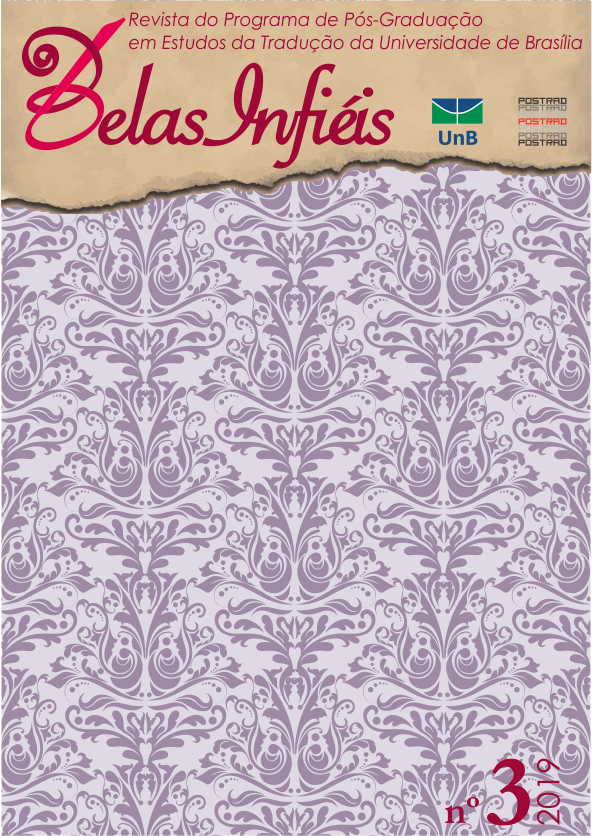Translating children’s literature: what, for whom, how, and why. A basic map of actors, factors and contexts
DOI:
https://doi.org/10.26512/belasinfieis.v8.n3.2019.25176Palabras clave:
Translation Studies. Children’s literature. Actors. Addressees. Map.Resumen
This article presents a systematic look at the different actors, factors, and contexts involved in the field of translating children’s literature. Taking as its point of departure the somewhat provocative question “Why translate children’s literature?”, it goes on to parse the three component parts. “Why?” involves looking at the motivation and interests of the various human and non-human actors (publishing houses, organizations, translators etc), as well as the complex interplay of geopolitical, economic, and cultural factors on publishing and literary transfer. Of the verb “translate” is asked “for whom?”, to examine questions of address and its role in translation, and then “how?”, to discuss determinants, strategies, and tendencies in translating children's literature. “Children’s literature”, the object of the translation activity, will be looked closely in response to the question “what?”, to illustrate the heterogeneity of its corpus and to show that it encompasses more genres and forms than are commonly featured in studies of translated children’s literature. The overall goal of the article is to provide a basic map of this complex field.
Descargas
Citas
Alvstad, Cecilia. “Publishing Strategies of Translated Children’s Literature in Argentina: A Combined Approach.” Meta : journal des traducteurs / Meta: Translators’ Journal, vol. 48, 1-2, 2003, pp. 266”“75.
Alvstad, Cecilia. “Children’s Literature.” Routledge Handbook of Literary Translation, edited by R. Kelly Washbourne and Ben van Wyke, Routledge, 2019, pp. 159”“80.
Ambatchew, Michael Daniel. “International Communities Building Places for Youth Reading.” Handbook of Research on Children’s and Young Adult Literature, edited by Shelby Wolf et al., Routledge, 2011, pp. 430”“38.
Baker, Mona and Gabriela Saldanha, editors. Routledge Encyclopedia of Translation Studies, Routledge, 2011.
Beauvais, Clémentine. “Translated into British: European Children’s Literature, (In)difference and Écart in the Age of Brexit.” Bookbird: A Journal of International Children’s Literature, vol. 56, no. 1, 2018, pp. 10”“18.
Becchi, Anna. “I Am a Translator, a Transmitter of Culture.” Bookbird: A Journal of International Children’s Literature, vol. 56, no. 1, 2018, pp. 62”“64.
Berry, Charlotte. “Quality not Quantity”: The Role of the Editor and the Language Consultant in the English Translations of Swedish and Norwegian Children’s Fiction at Turton & Chambers, 1988”“92.” Mémoires du livre, vol. 9, no. 1, 2017.
Büchler, Alexandra, and Giulia Trentacosti. Publishing translated literature in the United Kingdom and Ireland 1990 -2012: Statistical report. 2015, www.lit-across-frontiers.org/wp-content/uploads/2013/03/Translation-Statistics-Study_Update_May2015.pdf.
ÄŒermáková, Anna. “Translating Children’s Literature: Some Insights from Corpus Stylistics.” Ilha do Desterro, vol. 71, no. 1, 2018, www.scielo.br/scielo.php?script=sci_arttext&pid=S2175-80262018000100117.
Chambers, Aidan. “In Spite of Being a Translation.” Reading Talk, edited by Aidan Chambers, Thimble Press, 2001, pp. 113”“37.
Cullen, Catherine Ann. “All Better! Rewriting a Latvian children’s book for an Irish audience.” The Irish Times, 28 May 2019, www.irishtimes.com/culture/books/all-better-rewriting-a-latvian-children-s-book-for-an-irish-audience-1.3907094. Accessed 9 June 2019.
Desmet, Mieke K.T. Babysitting the Reader: Translating English Narrative Fiction for Girls into Dutch (1946-1995), P. Lang, 2007.
Fernández López, Marisa. “Translation Studies in Contemporary Children’s Literature: A Comparison of Intercultural Ideological Factors.” Children’s Literature Association Quarterly, vol. 25, no. 1, 2001, pp. 29”“37.
Flood, Alison. “Pushkin launches new imprint for children’s books in translation.” The Guardian, 07. May 2013, www.theguardian.com/books/2013/may/07/pushkin-imprint-childrens-books-translation. Accessed 8 June 2019.
Flugge, Klaus. “A Publisher’s Perspective.” Hallford and Zaghini, Hallford et al. 2005.
Ghesquiere, Rita. “Why Does Children’s Literature Need Translations?” van Coillie and Verschueren, Children’s Literature in Translation, 2006, pp. 19”“33.
Hahn, Daniel. Award-winning translator Daniel Hahn ponders the importance - or otherwise - of 3%. Booktrust. 2007, www.booktrust.org.uk/books-and-reading/translated-fiction/articles/daniel-hahn/.
Hallford, Deborah. A Decade in Children’s Literature in Translation (2005 ”“ 2014). 2016, www.outsideinworld.org.uk/childrens-books.asp?page=ArticlesNewsandLinks. Accessed 7 June 2019.
Hallford, Deborah, and Edgardo Zaghini, editors. Outside in: Children’s books in translation, Milet, 2005, www.outsideinworld.org.uk/childrens-books.asp?page=publications-outsidein.
Heilbron, Johan. “Towards a Sociology of Translation: Book Translations as a Cultural World System.” Critical Readings in Translation Studies, edited by Mona Baker, Routledge, 2010, pp. 304”“16.
Jensen, Eline Morch. “Communicating the Strange: The entire world into the kids’ room and the class room …”. KLODSHANS, July 2012, 2012, pp. 18”“22.
Ketola, Anne. “Picturebook Translation as Transcreation.” In Search of Meaning: Literary, Linguistic, and Translational Approaches to Communication, edited by Hanne Juntunen et al., Universität of Tampere, 2018, pp. 127”“43.
Kreller, Susan. Englischsprachige Kinderlyrik: Deutsche Übersetzungen im 20. Jahrhundert, Lang, 2007.
Lathey, Gillian. “The Translator Revealed. Didacticism, Cultural Mediation and Visions of the Child Reader in Translator’s Prefaces.” van Coillie and Verschueren, Children’s Literature in Translation, 2006, 1-18.
Lathey, Gillian. The Role of Translators in Children’s Literature: Invisible Storytellers, Routledge, 2010.
Lathey, Gillian. “Serendipity, Independent Publishing and Translation Flow: Recent Translations for Children in the UK.” The Edinburgh Companion to Children’s Literature, edited by Clémentine Beauvais and Maria Nikolajeva, Edinburgh University Press, 2017, pp. 232”“44.
Lepman, Jella. A Bridge of Children’s Books: The Inspiring Autobiography of a Remarkable Woman. Translated by Edith McCormick, O’Brien Press, 2002.
Marcus, Kendra. “Buying and Selling International Children’s Book Rights. A Literary Agent’s Perspective.” Publishing Research Quarterly, vol. 19, no. 1, 2003, pp. 51”“56.
Martin, Ruth. Remembering Anthea Bell. New Books in German. 2019, www.new-books-in-german.com/remembering-anthea-bell. Accessed 15 June 2019.
McGillis, Roderick. The Nimble Reader: Literary Theory and Children’s Literature. Twayne Publishers, 1996
McMartin, Jack, and Jan van Coillie, editors. Children’s Literature in Translation: Texts and Contexts, University of Leuven Press, forthcoming.
Mdallel, Sabeur. “Translating Children’s Literature in the Arab World: The State of the Art.” Meta: journal des traducteurs / translators’ journal, vol. 48, 1-2, 2003, pp. 298”“306.
Millán-Varela, María del Carmen. “(G)alicia in Wonderland: Some insights.” Fragmentos, jan-jun, 1999, pp. 97”“117.
Oittinen, Riitta. Translating for Children, Garland, 2000.
O’Sullivan, Emer. “Translating Pictures. The Interaction of Pictures and Words in the Translation of Picture Books.” Signal, no. 90, 1999, pp. 167”“75.
O’Sullivan, Emer. “Narratology meets Translation Studies, or, The Voice of the Translator in Children’s Literature.” Meta, vol. 48, 1-2, 2003, pp. 197”“207.
O’Sullivan, Emer. Comparative children’s literature, Routledge, 2005.
O’Sullivan, Emer. “Two languages, two children’s literatures: translation in Ireland today.” Children’s Literature in Translation: Texts and Contexts, edited by Jack McMartin and Jan van Coillie, University of Leuven Press, forthcoming.
Nel, Philip and Lissa Paul, editors. Keywords for Children’s Literature. NYU Pres, 2011.
Parkinson, Siobhán. “English than that for me! Publishing children’s books in translation.” Children’s Literature on the Move: Nations, Translations, Migrations, edited by Nora Maguire and Beth Rodgers, Four Courts Press Ltd, 2013, pp. 151”“60.
Parkinson, Siobhán. “Happy 5th birthday, Little Island: Siobhán Parkinson traces the history, successes, challenges and ambitions of the children’s publisher she helped found in 2010 as it launches its 50th book.” The Irish Times, 13 May 2015, www.irishtimes.com/culture/books/happy-5th-birthday-little-island-1.2211315. Accessed 6 Feb. 2019.
Parkinson, Siobhán. “Watch out for the Umlauts! Children’s Books in Translation from Little Island.” writing.ie. The complete online writing magazine, 28 Apr. 2016, www.writing.ie/interviews/children-young-adult/watch-out-for-the-umlauts-childrens-books-in-translation-from-little-island-by-siobhan-parkinson/.
Plenge, Vagn. “Getting books from south to north.” Peace through children’s books. Proceedings of the 26th congress of the International Board on Books for Young People, New Delhi, India, 20.24 Sep., 1998, Association of Writers and Illustrators for Children, [1999], pp. 420”“29.
Salisbury, Martin C. “No red buses please: International co-editions and the sense of place in picturebooks.” Bookbird, vol. 44, no. 1, 2006, pp. 6”“12.
Seifert, Martina. “The image trap: The translation of English-Canadian children’s literature into German.” Children’s Literature Global and Local: Social and Aesthetic Perspectives, edited by Emer O’Sullivan et al., Novus Press, 2005, pp. 227”“39.
Shavit, Zohar. “Translation of Children’s Literature as a Function of its Position in the Literary Polysystem.” Poetics Today, vol. 2, no. 4, 1981, pp. 171”“79.
Sinibaldi, Caterina. “Pinocchio, a Political Puppet: the Fascist Adventures of Collodi’s Novel.” Italian Studies, vol. 66, no. 3, 2011, pp. 333”“52.
Steiner, Ann. “The Global Book: Micropublishing, Conglomerate Production, and Digital Market Structures.” Publishing Research Quarterly, vol. 34, no. 1, 2017.
Stephens, John. Language and Ideology in Children’s Fiction, Longman, 1992.
Stolt, Birgit. “How Emil Becomes Michel: On the Translation of Children’s Books.” Children’s Books in Translation, edited by Göte Klingberg et al., Almqvist & Wiksell International, 1978, pp. 130”“46.
St-Pierre, Paul. “Translation as a Discourse of History.” TTR : traduction, terminologie, rédaction, vol. 6, no. 1, 1993, p. 61.
Tang, Rui. “Chinese Children’s Literature in the 21st Century.” Bookbird, vol. 44, no. 3, 2006, pp. 21”“29.
Thomson-Wohlgemuth, Gaby. Translation under State Control: Books for Young People in the German Democratic Republic, Routledge, 2009.
TRANSLATION. Daniel Hahn advocates for children’s literature [Interview]. 2019, www.wordsandpics.org/2019/04/translation-danny-hahn.html. Accessed 9 June 2019.
Tucker, Nicholas. “Why is There a British Problem?” Hallford and Zaghini, Hallford et al. 2005.
van Coillie, Jan, and Walter Verschueren, editors. Children’s Literature in Translation: Challenges and Strategies, St. Jerome Publishing, 2006.
van Coillie, Jan, and Walter Verschueren, editors. “Editors’ Preface.” van Coillie and Verschueren, Children’s Literature in Translation, pp. v”“ix.
Venuti, Lawrence. The Translator’s Invisibility. A History of Translation, Routledge, 1995.
Washbourne, R. Kelly and Ben van Wyke, editors. Routledge Handbook of Literary Translation, Routledge, 2019.
Descargas
Publicado
Cómo citar
Número
Sección
Licencia
Copyright Statement
Given the public access to this journal, the texts are free to use but requires the recognition of the original authorship and initial publication in this journal to be properly stated.
The journal allows the use of works published for non-commercial purposes, including the right to submit the work to publicly accessible databases. Published contributions are the sole and exclusive responsibility of the author(s).
- When submitting papers to be evaluated by the Belas Infiéis journal, the author(s):
- Declare that the contents of the contributions are original and of their original creation, being entirely responsible for their content if there is an objection by third parties.
- Claim to be aware that they should not commit academic plagiarism.
- Declare that the manuscript has not been published, completely or partially, in Portuguese or another language. If it is a translation it should be submitted to the Translated Articles section.
- Declare that the manuscript is not being evaluated by other journals.
- Declare that the manuscript was not submitted to another journal simultaneously.
- Commit(s) to inform the journal of any kind of error or inaccuracy in their contribution (published, in evaluation or in editing) and to collaborate with the editors to make due corrections of the article (when in evaluation or editing) or erratum/retraction (after publication).
- Declare that there is no conflict of interest regarding the published work.
- Authorize its release if it is accepted for publication without any kind of monetary compensation.
- Agree to assign non-exclusive rights to publication to the magazine, remaining free to make their contribution available in other media as long as the publication of the first version in Belas Infiéis magazine is mentioned. They also authorize Belas Infiéis to assign their texts for reproduction in content indexers, virtual libraries and similar platforms.
- Maintain copyright and grant the journal the right of first publication, the work being licensed under theCreative Commons Attribution License.
- Is/Are allowed and encouraged to publish and distribute their work online after the editorial process, which may increase the impact and citation of the published work.
- Authorize the editorial team to make textual adjustments and to adapt the article to the publication rules, when necessary.



















